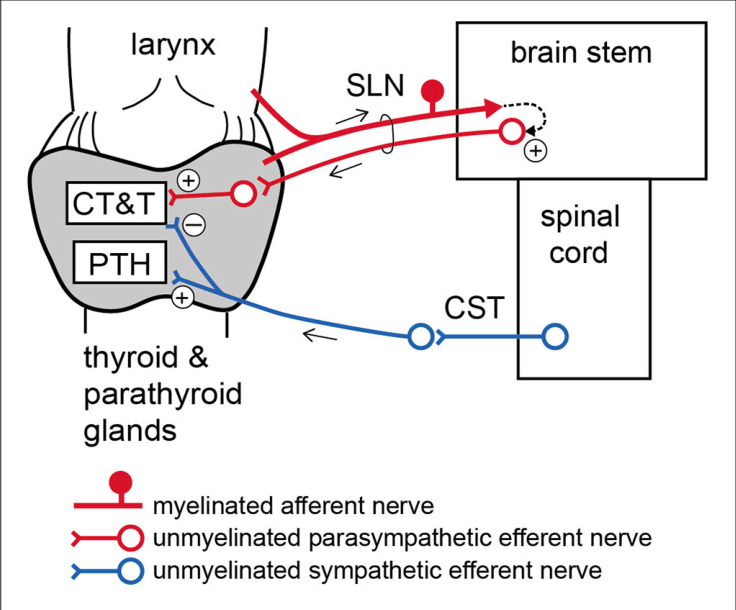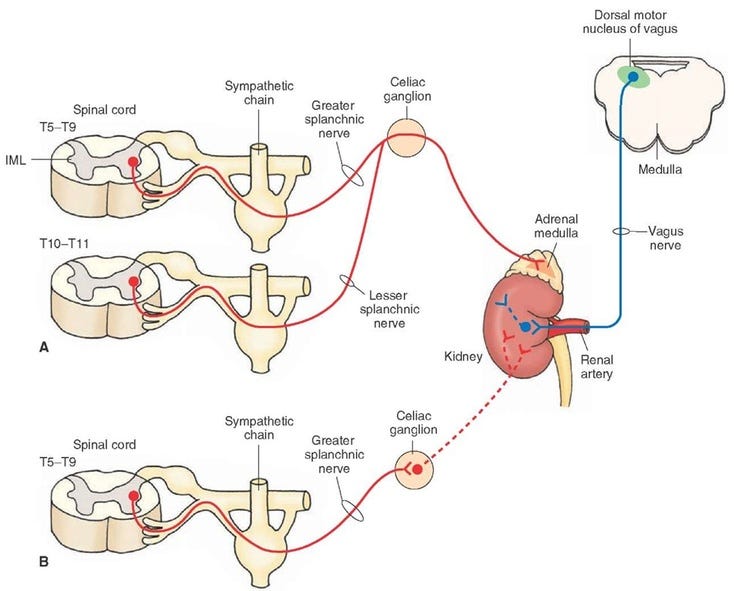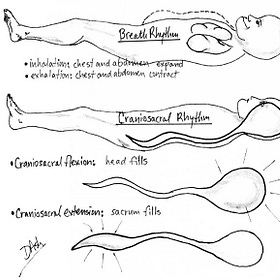The nervous system is the master system of the body, controlling and regulating nearly all bodily processes at all points in time. Inputs from the external and internal worlds are taken in and processed, helping to determine the adaptations that need to take place with both the short and long term in mind.
The brain and spinal cord are also one of the first aspects of anatomy to take shape during gestation. Here, many other organs then sprout from it like fruit from a tree. In the mature body, these organs should be viewed as extensions of the nervous system.
The function of organs, the secretion of hormones, and the state of one’s metabolism is often subservient to the nervous system. It doesn’t necessarily micro-manage any of these things but determines what “mode” or “state” they are to run in.
This is largely controlled by the autonomic nervous system (ANS), which is constantly running in the background helping to manage aspects of existence that keep you alive from one moment to the next. Thankfully we do not need to think or even act for this system to do what it needs to do.
The ANS has two modes of operation: parasympathetic and sympathetic. The parasympathetic (rest, digest, reproduce) promotes functions that sustain life over long periods, and the sympathetic (fight, flight, freeze) protects life for short periods. Life is a dance of the two as at any given point in time you will be operating in one state.
The parasympathetic is our natural state of being, one of rest, growth, and expansion. Here energy is produced effectively (via thyroid metabolism), food is digested, and repair/growth can occur. The majority of these nerves lie in the cranium and the sacrum, as well as the vagus nerve which spreads out through the vital organs of the abdomen.

Under the threat of harm, the sympathetic nervous system helps redirect energy toward immediate survival via the secretion of stress hormones. Long-term processes of health including thyroid metabolism and digestion are put on hold as these are unnecessary during life or death scenarios. Sympathetic nerves are located primarily in the torso and limbs as these --the muscles-- are what help us deal with stress.

Ideally, once the threat has disappeared, a parasympathetic state can be resumed. There will always be a balance between the two, however, the parasympathetic should be dominant in the sense that you should not always be fighting for your life. Abuse of sympathetic mechanisms will eventually lead to chaos and degeneration throughout the body.
Another important aspect of the ANS involves the gut. The concentration of nerves in the gut (more than in the spinal cord) makes up the enteric nervous system (ENS). This serves as a sensory mechanism for the ANS, communicating the status of the gut via the vagus nerve. If something irritates or otherwise bothers the gut, the sympathetic nervous system is piqued and the parasympathetic inhibited.
This is why stomach aches and bouts of food poisoning are accompanied by changes to thought patterns, difficulties with muscle tone, increased breathing rates, and a number of other autonomic symptoms. The same can be true on a lesser scale, as minor disturbances can do so subtly. Outside stressors can go on to disrupt your gut via this same pathway.
The fascia and skin are another sensory interface for the autonomic nervous system. The fascia’s ability to transmit mechanical information by the body is interpreted by the ANS and relayed to the brain. Healthy fascia is important for autonomic function and vice versa.
You can read more about fascia here:
Living Fascia
Fascia is often thought of as simply being an inert wrapping for muscles/organs, perhaps because dissection and study rarely happens in living organisms. In reality, it is an essential energetic, sensory, and nutrient-delivery organ. This includes mechanical proprioception, autonomic innervation, electron/biophoton conduction, and stem cell propagation.…
The craniosacral pump nourishes the parasympathetic nerves in cranium and sacrum. If insufficient, these nerves can be starved of nutrition and neurotransmitters, potentially leading to dysfunction of the autonomic nervous system as a whole.
You can read more about the craniosacral system here:
The Craniosacral System
The brain and spinal cord float in a clear liquid known as cerebrospinal fluid (CSF). This fluid helps to protect, nourish, and remove waste from the vital tissue. Thought as the medium for consciousness, the state of the CSF will determine that of the entire organism.
The binary nature of the ANS is not necessarily absolute as different parts of the body can exist in different states at once. Harmony within the system is important for ensuring total coherence of the entire organism. This is related to the idea of chakras and their potential "blockage", which is also likely has to deal with the flow of cerebrospinal fluid through the spine.
The sympathetic is an energy loan system, continuing to borrow without repaying can result in:
Insufficient digestion (lack of acid, bile, and enzyme secretion, slow/weak peristalsis)
Impaired thyroid metabolism (thyroid hormone secretion is paused)
A stymied craniosacral pump
A systemic shift from sex steroids (progesterone, DHT) to stress steroids (cortisol, estrogen)
Fibrosis and hardening/stiffening of tissue
Again these are not an issue when the sympathetic nervous system is tapped into on occasion. In fact, this is actually necessary to ensure that this occurs to keep our senses and skills honed while also allowing us to accomplish whatever it is we need in life. Exercise, work, and even play will all eventually incorporate the sympathetic. The goal is to be able to return to a parasympathetic state quickly and easily when this is over.
When running in predominantly parasympathetic mode the following can occur:
Thyroid metabolism (via vagal innervation)
All aspects of digestion (acid/bile/enzyme/mucus secretion, peristalsis)
Craniosacral rhythm (health of the brain and spinal cord)
Breathing
Sleep
Relaxation, play, love
It’s important to understand that all of these require parasympathetic tone and cannot occur without it. As you can imagine, the amount of downstream effects from these being active or inactive are mind boggling. Again, how you breathe, how your cells generate energy, and how you harness energy from food is, in large part, determined by the state of your autonomic nervous system. This means that you could be a walking corpse or a vibrant bundle of life.
What can cause sympathetic stimulation?
Insufficient nutrition (glucose, sodium, magnesium, calcium, thiamine)
Life-threatening situations (perceived)
Hyperventilation
Irritation or disruption to the gut
Exposure to toxic substances
Psychological trauma/stress
Physical injuries to nerves/fascia
A dysfunctional craniosacral pump
Anything that threatens life to any degree can drive a sympathetic response. This could be from an outside threat or an internal one as well. These internal threats include a lack of energy, often in the form of blood glucose and various electrolytes. Since deficiencies in glucose and some minerals would be fatal in a short period of time they are treated similarly to external dangers.
What enables parasympathetic function?
The absence of perceived stress
Sufficient nutrition (especially glucose, sodium, magnesium, calcium, thiamine)
Slow respiration (relaxed exhales)
A clean and happy gut
A working craniosacral pump
Since this is all meant to be unconscious, you shouldn’t need to consciously force a parasympathetic state. Oftentimes all that needs to happen is for stressors to be removed. This is true for the internal and external environment. A lack of certain nutrients is a stressor just the same as exhaustive exercise. Taking away the stress will allow for a natural balancing of the ANS.
The influence of the autonomic nervous system on your life needs to be appreciated no matter what is you do or wish to achieve. It can help make sense of bewildering health issues or help to unlock aspects of life previously inaccessible.
If you’d like to read more about the autonomic nervous system as a whole and learn practical ways to balance it, I go into far more detail in my eBook which can be purchased here: How To Harmonize Your Nervous System












